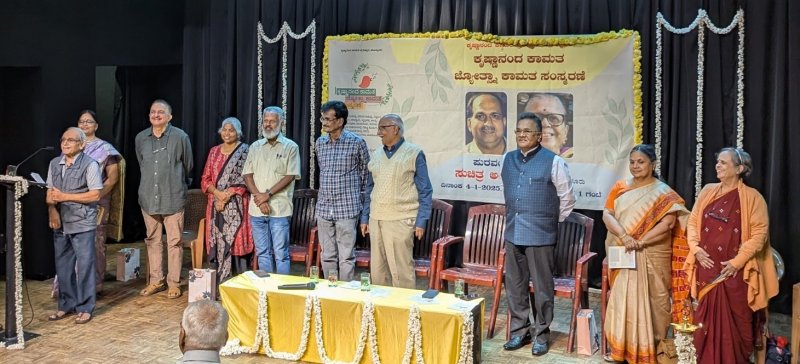How the Mourning Turned into a Celebration
by Nagesh Hegde
First Online: January 4, 2025
Page Last Updated: April 21, 2025
Author: Nagesh Hegde (via Facebook Post),
translated into English via experimental AI.
Kannada Language version is archived here.

We honored the Kamat couple with a Smile Salute!
Dr. Krishnanand Kamat and Dr. Jyotsna Kamat's cherished memories came alive at a recent event. Their son, Vikas Kamat who resides in USA attended, although their daughter-in-law, Dr. Kim, a native of South Korea, and their granddaughter, Mina Kamat (12), were not present.
We had a discussion with ten people. The setting wasn't extravagant but simple and warm. The inauguration was led by Vishweshwara Bhat. Following that, I (Nagesh Hegde), along with S. Divakar, Nemachandra, and Jayanta Kaikini, spoke. After me, N. Gayathri, H.V.Krishnamurthy, Dr. M. Bhyregowda, Dr. Sushma Arur, and Dr.Shesh Shastry shared their thoughts.
Jayanta Kayikini's words struck a chord with everyone:
"Every moment in this commemoration, from joy to contemplation, was filled
with a special charm. Silence wasn't necessary here; everyone could share a
happy laugh."
Dr. G.S. Amur, a renowned English and Kannada literary scholar, once
reminisced about Kamat's days at Kumta College, where Kamat was a hostel warden:
"Kamat's smile was so genuine and constant that I believe he might have even
smiled in his sleep. Ask Jyotsna, his wife, who was also one of my students."
This memory brought smiles to everyone in attendance. Following this, Dr.
T.R. Anantharamu quoted a poetic comparison during a discussion about Kamat's
multifaceted life:
"Dr. Kamat is like Shivaganga Mountain. From one direction, he appears like
Shiva's linga; from another, like the towering Nandi; from yet another, like the
serene Ganapati."
Kamat's daughter-in-law, Kim, also shared her thoughts, stating:
"Just like navigating complex scientific discussions in America is
challenging, so too was understanding Bappa's [father-in-law's] insightful
talks."
Scientific and Environmental Contributions
Dr. Krishnanand Kamat pursued his Ph.D. in soil sciences in the 1960s in America, during a period when India was grappling with brain drain. Although invited back under a government scheme, political hurdles prevented him from continuing his work in India. Consequently, Kamat remained abroad and integrated his scientific pursuits with personal passions such as photography, field research, ornithology, and tribal anthropology.
Kamat's home near the Indian Institute of Science (IISc) became a hub for his creative pursuits. He established a "Scientific Photography Studio," where he developed and printed photographs himself, particularly those crucial for scientific publications. He also meticulously documented lesser-known societies and environments in India, creating an archive for future generations.
Renowned poet V.G. Bhat, inspired by Kamat's collection of memorabilia, wrote
a tribute:
"Kamat's treasure trove brings back the past to life, preserves history,
carrying its weight, on a path leading us to heritage."
Kamat was deeply concerned about the degradation of India's natural habitats. He criticized the lack of forestry-related education in agricultural colleges and called for the establishment of institutions dedicated to forest and environmental sciences.
In one of his reflections, Kamat remarked:
"We have a tendency to export everything, from the timber of our forests to
the hair from Tirupati's offerings. But we forget that nurturing our natural
resources is more valuable than selling them."
He also envisioned sculptures of birds made by artisans, emphasizing the role of art in promoting environmental awareness.
Cultural and Literary Contributions
Despite his global exposure, Kamat remained deeply connected to Kannada literature and cultural heritage. He supported and contributed to the Kannada literary community through essays and speeches.
One of his significant achievements was the establishment of a personal library, "Krishna Kala," in his native town of Honnavar. The library housed rare books, manuscripts, and artifacts he had collected over the years. Friends and family later revived the neglected library, uncovering invaluable works. Kamat's son, Vikas, furthered this legacy by creating an online archive (www.kamat.com), ensuring that his father's contributions reached a global audience.
Jayanta Kayikini described the couple beautifully:
"Krishnanand was a silent genius, while Jyotsna was the voice that resonated
across boundaries, much like the airwaves of Akashvani (All India Radio)."
A Visionary for the Future
Kamat's passion extended to bird migration patterns. He documented the decline of migratory birds in Bengaluru due to urbanization and water mismanagement. His work highlighted the ecological and cultural significance of birds, urging society to take a more active role in conservation.
In his later years, Kamat expressed disappointment at India's lack of
institutional support for innovation. He once wrote:
"Our country has no shortage of intellectuals, but we often fail to
recognize and nurture their potential. We must strive to create a system that
values knowledge and innovation above all else."
Legacy and Final Reflections
Kamat's passing left a void in both the scientific and literary communities. His contributions to Kannada literature, environmental science, and cultural preservation continue to inspire generations.
At a commemorative gathering, Jayanta Kayikini aptly summarized Kamat's life:
"Kamat's enduring smile was a reflection of his boundless optimism, while
Jyotsna's voice carried the depth of their shared vision. Together, they
exemplified a perfect balance of silence and expression."
As Kamat once said:
"True legacy lies not in wealth or fame, but in the lives we touch and the
ideas we ignite."
